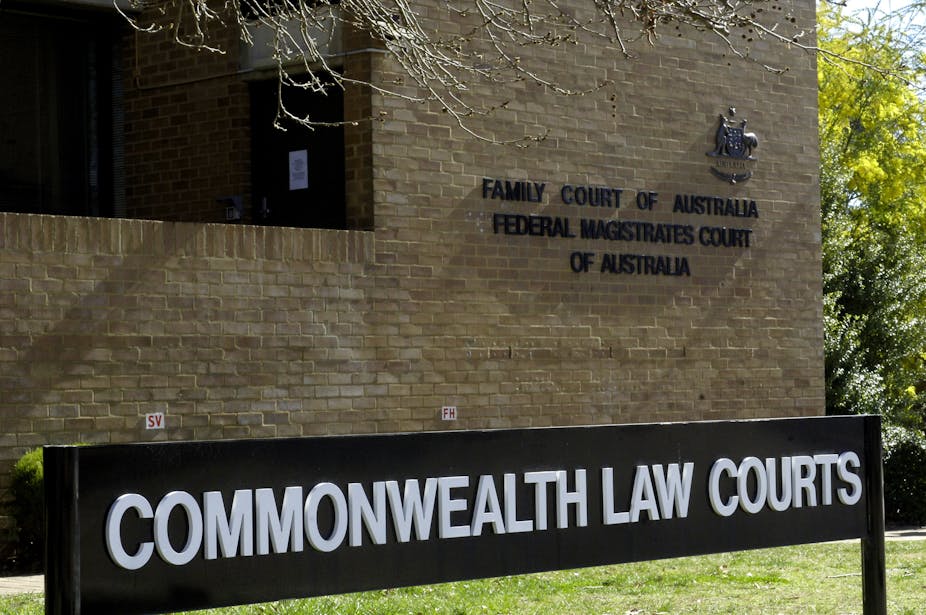The federal government looks set to merge the administration of three of Australia’s federal courts — the Federal Court, the Family Court and the Federal Circuit Court – with the aim of saving A$6 million over four years.
While the government has said that the proposed model will “preserve the courts’ functional and judicial independence”, what has been foreshadowed appears to be less a collaborative model and more one in which the Federal Court will simply assume administrative responsibility for the other two courts.
The rationale for that approach is unclear. It could have significant implications for the way in which resources are allocated to meet the needs of Australia’s family courts and their clients.
Feeling the pinch
The Federal Circuit Court was designed to provide a faster, simpler and more accessible alternative to the Family Court and the Federal Court. In practice, family law matters make up most of its workload – 91% in 2014-15.
But the Federal Circuit Court is under pressure. Its annual report reveals that the number of new family law filings in the court grew 3.5% for the year 2014-15 (to 86,380), while the number of cases concluded remained relatively static (81,744).
These figures tell only part of the story. As chief judge John Pascoe has pointed out, this workload is being dealt with by fewer judges. Of the four new judges recently appointed to the court, only one is a family law expert.
Waiting times for trials have grown and recent reports suggest that some judges may be carrying workloads of up to 700 cases. The court finalised only 73% of final order applications in 2014-15, well down on its target of 90%.
The Family Court deals with more complex family law matters and appeals in family matters from the Federal Circuit Court. In 2014-15, the number of notices of appeal grew by 18%. None of this is good news for families and litigants caught up in family law matters.
What’s happened elsewhere?
The US and Canada have centralised court administration support functions for their federal courts. However, unlike Australia, in those countries the high-volume family law jurisdiction, with its special needs, is a matter for state – or provincial – courts.
Two Australian states – South Australia and Victoria – have centralised court administration under what are essentially collaborative models. The head of each court has a seat at the table. Their establishment has been driven by the need to ensure judicial independence and provide greater autonomy and flexibility in allocating resources to meet administrative needs and functions.
However, the move to centralisation at federal level appears to be driven by the executive, rather than the courts, and motivated primarily by reducing costs.
Why it matters
Rationalising administration sounds innocuous in terms of payroll, communications and judge travel. But court administrative functions also impact directly on the service court users receive by way of support and information, efficiency of case processing, and ancillary services such as alternative dispute resolution, interpreting, family support, IT and court security.
Family court clients often have specific needs and vulnerabilities. And at a time when there is a national commitment to addressing family violence, a federal inquiry underway into child abuse, and increasing attention on issues of mental illness and drug addiction, it is vital to ensure that Australia’s family courts are well-equipped to tackle the flow-on effects of these problems in family court cases.
Family Court Chief Justice Diana Bryant has reported an increasing number of cases involving mental illness and substance abuse, as well as the complexities of matters involving family violence or allegations of child abuse.
Those factors have obvious implications – not just for the workload of judges, but also for support staff dealing with those clients.
These courts have high levels of people who handle their own court cases because they can’t afford, or don’t want, to engage a lawyer. Skilled administrative staff play an important role in providing the additional information and support they need.
Problems associated with increased judicial workloads are also unlikely to be fixed by a focus on “back-end” operations. Their solution might require more resourcing, not less. These resources might be used to support a renewed focus on case management and workforce planning in the Federal Circuit Court, as well as judicial appointments.

